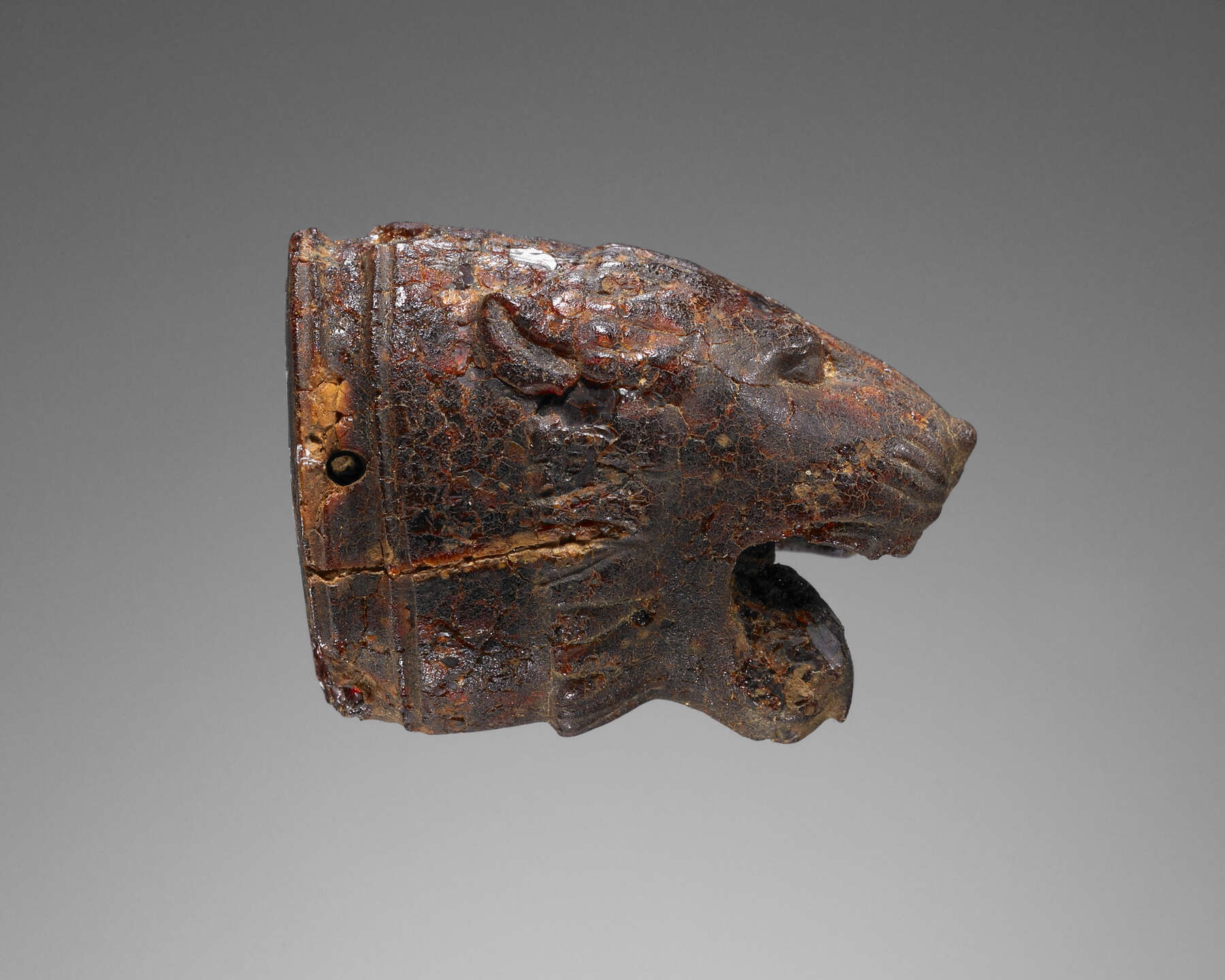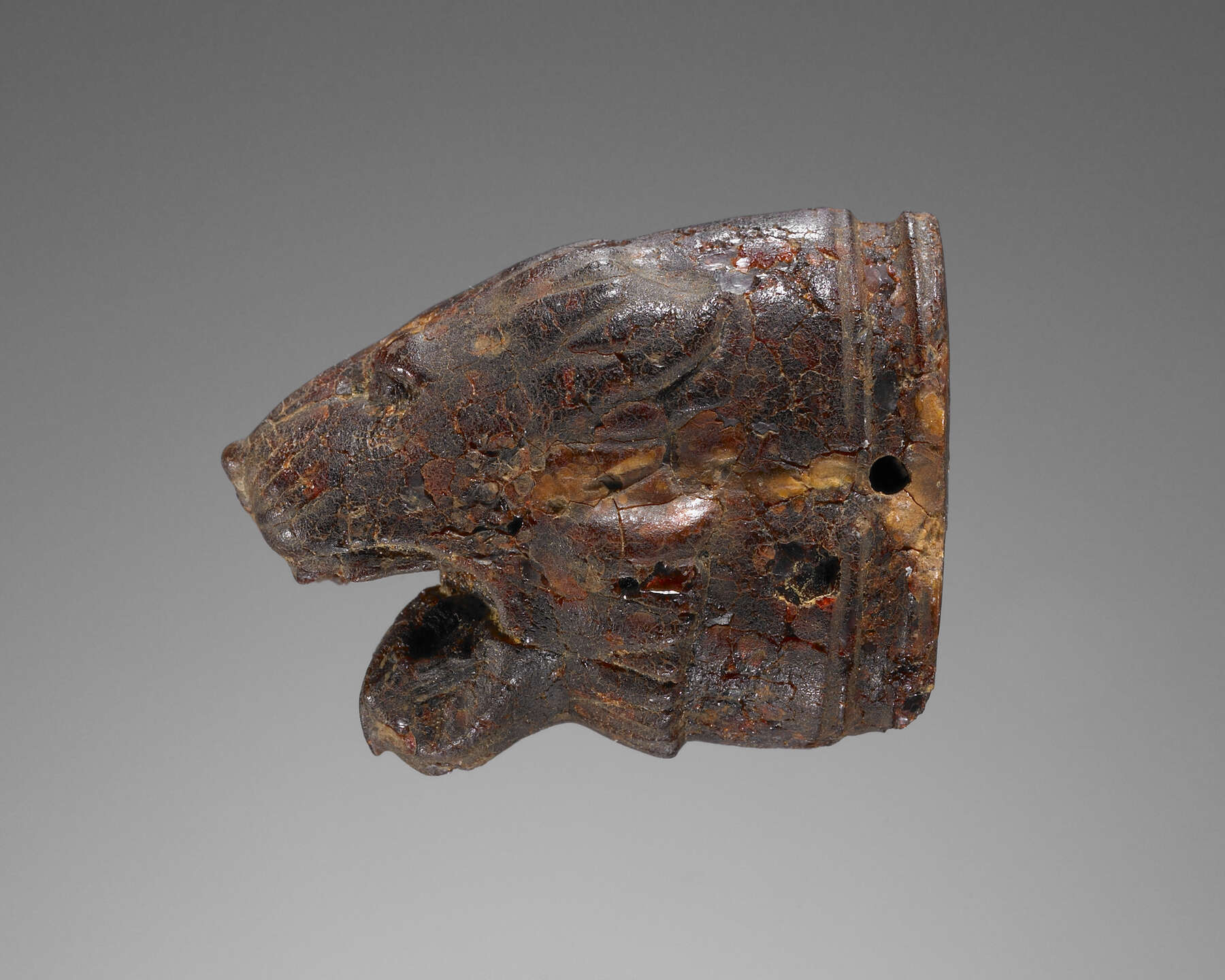33. Pendant: Lion’s Head
| Accession Number | 76.AO.80 |
| Culture | Etruscan |
| Date | 550–500 B.C. |
| Dimensions | Height: 28 mm; width: 22 mm; depth: 38 mm; Weight: 13.6 g |
| Subjects | Funerary use of amber (also Burial); Lion |
Provenance
–1976, Gordon McLendon (Dallas, TX), donated to the J. Paul Getty Museum, 1976.
Condition
The pendant is in good condition, with a generally smooth surface. There is a large nonmodern chip behind the right side of the chin and four broken teeth; there are also many tiny modern chips and cracks and crazing over the entire surface. Inclusions are visible in one crack on the right side of the neck. All over the surface are small blotches of a pale yellow-ocher patina. Degraded amber fills many of the fine cracks. The piece is dull brownish red in ambient light and bright red in transmitted illumination.
Description
The pendant consists of the head and upper neck portion of a ferocious lion, mouth open wide, tongue extended, teeth bared, and ears flattened against the head. The forehead, medial indentation, areas around the eyes, and top of the snout are richly modeled, suggesting a subcutaneous musculature (even if it is not anatomically correct). The eyes are rendered plastically, in profile appearing narrow and hooded and in frontal view open and rectangular, in a gaze of focused concentration. Emphasizing the raised elliptical domes of the eyeballs, their upper lids are undercut.
The pert nose is delineated by two outward-curving nasal wrinkles. The tip of the nose is flat on the frontal plane and tilted upward in profile. A raised philtrum separates the halves of the muzzle; the wrinkled snarl lines on either side are engraved with four lines parallel to one another on the frontal plane and turned up on the sides. The edge of the mouth is smooth. The flews are not turned out. The lips are undercut to reveal the ridges of the gums and the teeth. Only the stumps remain of the upper and lower canines. The chin is narrower and shorter than the upper jaw. The extended position of the tongue (slightly asymmetrical to right) and the cavern of the deeply hollowed palate emphasize the lion’s ferocious expression. From the front, the head is oval, with the mane fitting tightly around the head; in profile, the head is long, with the mane flowing from the edge of the face to the edge of the skull. The ruff is composed of a pattern of pinnate, plastically rendered hanks of hair on top; shorter, triangular sections of the mane are carved in the interstices. On the sides and under the neck, the mane is more schematically rendered and the forms flatter. The soft folded-over ears emerge from the mane (the right one is more legible than the left).
The left side of the head is indented along a broad, shallow groove, making the head slightly asymmetrical, and gives evidence of the original shape of the amber blank from which the object was carved. The pendant was perforated with two 2 mm holes, each initiated on one side of the finial (collar?) and exiting caudally through the base. The finial consists of a 3 mm flute flanked on each side by raised fillets. When suspended, the head would have hung downward, with the top of the head showing.
Discussion
The signs of use wear of 76.AO.80 are significant. The pulling troughs on the upper edges of the perforation demonstrate longtime use where gravity or human activity has caused the suspension cord to saw the amber. This is the only animal head in the Getty collection to demonstrate this use; the other ambers in the collection with visible wear by abrasion are female head-pendants. Unlike on the female head-pendants, however, there is little corresponding wear on the face. There is no internal evidence to suggest the manner of the pendant’s use, whether as personal adornment (and whether it was talismanically rubbed or kissed) or as an ornament suspended from a branch, animal harness, or architectural element.
Counterparts for 76.AO.80 were found in female graves in controlled excavations, and it is possible that this piece came from a similar context. While representations of both ram’s head–wearing women and men are documented in funerary imagery, there is no comparable image of a lion’s-head wearer of either sex. Whatever may have been the pre-interment function of the amber, gold, and bronze lions’ heads, their ultimate role was funerary, just like the necklaces with lion’s heads hanging from the branches in the grove of the Etrusco-Ionian Tomb of Hunting and Fishing (see the “Lions’ Heads” introduction).

